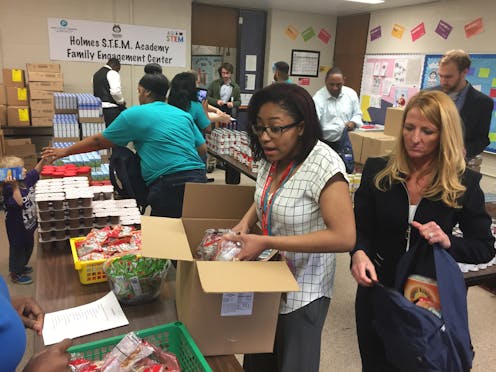It can take a village to feed hungry kids in schools
Backpack programs that give students easily prepared foods, like boxed macaroni and cheese and canned beans, can make a difference.

One in 6 American children faces hunger and 3 out of 4 teachers report regularly seeing hungry kids in their classrooms. In response, school meals make up a large fraction of federal food assistance.
The National School Lunch Program is the second-largest federal food assistance program, serving 30.4 million children. It is complemented by the School Breakfast Program, the Afterschool Snack Service and the Summer Food Service Program. Though these programs are essential, they are not enough.
On a local scale, organizations such as food banks assist food-insecure children and families, but their work within schools is typically limited. In my roles as a researcher of food in schools and as a food bank board member, I often see opportunities for more collaboration between schools and communities to help fill the gaps in feeding kids whose families face economic hardship.
Local efforts are limited
In some communities, food banks and K-12 schools already work together as partners.
One way this occurs is through backpack programs that give students easily prepared foods, like boxed macaroni and cheese and canned beans, for the weekend. Backpack programs, such as those in Northeast Michigan and Arlington, Virginia, are highly local.
Often these initiatives exist because someone, such as a high school teacher I collaborated with on a study, Melissa Washburn, sees a need and reaches out to local food banks for support. Washburn, a health teacher at a public high school in Lansing, Michigan, partnered with a nearby food bank to initiate a backpack program that delivered shelf-stable items. Wanting to improve the quality of the food in the packs, Washburn secured grants from a local nonprofit and the schools’ alumni association to include locally sourced fruits and vegetables.
Food pantries located in schools are another source of support for hungry students and their families. These efforts also often depend on one or a handful of dedicated people who see a need and amass volunteers for the task.
Local efforts are important and should be the norm rather than the exception. School-based food pantries and weekend backpack programs should be a routine feature at all public schools.
Bringing in the village
While school food pantries and backpack programs are important, we need to welcome more ideas to the table to feed children in schools. Because funding for public education is limited and teachers are overextended, the village needs to help support these endeavors.
There are countless models for marshaling communities to feed students. Service organizations, faith-based groups and local clubs can step in to help. Food banks, in particular, are in excellent positions to foster connections between schools and these groups. For example, a network of churches in Junction City, Oregon, works with the food bank to supply items, such as peanut butter, for backpack programs in local schools.
Partnerships between businesses and nonprofits, such as the Cereal for Youth program in Lane County, Oregon, are another model. This program brings three local businesses together with the food bank to provide free high-quality granola to kids 18 years and under in schools or afterschool programs.
Another important initiative is lobbying for better federal or state school food assistance. In Oregon, nonprofits, food banks and other organizations have formed the Hunger-Free Schools Coalition to encourage state legislators to make Oregon the first state to provide universal free school meals.
Food can also provide a gateway to building community in and around schools. For example, our food bank nutrition educator teaches family cooking classes at a local elementary school. Free evening or weekend meals for school communities with food provided by food banks and partners are another possibility.
Schools are places where food assistance can have great impact on vulnerable members of society. Community organizations, businesses and food assistance agencies all have roles to play in this effort.
Sarah Riggs Stapleton is affiliated with Food for Lane County as a (volunteer) member of the Board of Directors.
Read These Next
How to reduce gift-giving stress with your kids – a child psychologist’s tips for making magic and a
Depending on family circumstances and a child’s personality type, gift giving runs the gamut of fun…
The world risks forgetting one of humanity’s greatest triumphs as polio nears global eradication − 7
Polio may finally be defeated in the next 5 years. Will the world recognize what an extraordinary achievement…
Medieval peasants probably enjoyed their holiday festivities more than you do
The Middle Ages weren’t as dreary and desperate as you’d think, and peasants often had weeks of…





